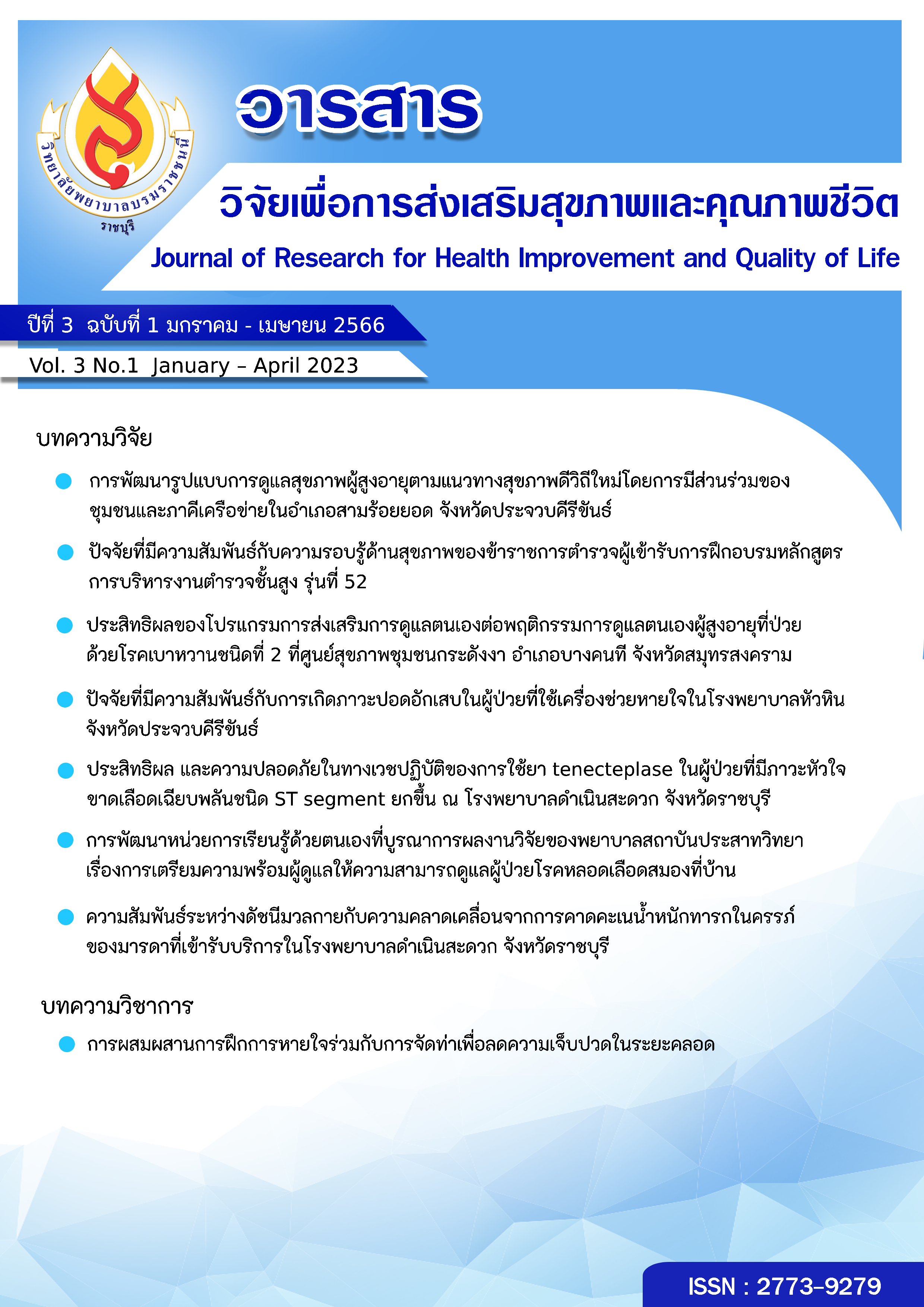ปัจจัยที่มีความสัมพันธ์กับอุบัติการณ์การเกิดภาวะปอดอักเสบในผู้ป่วยที่ใช้เครื่องช่วยหายใจ ในโรงพยาบาลหัวหิน จังหวัดประจวบคีรีขันธ์
คำสำคัญ:
อุบัติการณ์, บริหารหลักสูตร , ภาวะปอดอักเสบจากการใช้เครื่องช่วยหายใจบทคัดย่อ
การวิจัยครั้งนี้มีวัตถุประสงค์เพื่อศึกษาปัจจัยที่มีความสัมพันธ์กับอุบัติการณ์การเกิดภาวะปอดอักเสบในผู้ป่วยที่ใช้เครื่องช่วยหายใจในโรงพยาบาลหัวหิน จังหวัดประจวบคีรีขันธ์ ศึกษาข้อมูลย้อนหลังจากเวชระเบียนของกลุ่มตัวอย่างเป็นผู้ป่วยที่ใส่ท่อช่วยหายใจและเครื่องช่วยหายใจ ในโรงพยาบาลหัวหินตั้งแต่ มกราคม 2564 ถึงวันที่ ธันวาคม 2564 จำนวน 430 คน เก็บรวบรวมข้อมูลด้วยแบบบันทึกข้อมูล วิเคราะห์ข้อมูลโดยใช้สถิติเชิงพรรณนา และวิธีการทดสอบไคสแควร์ ผลการวิจัยพบว่า
1. การใส่ท่อช่วยหายใจซ้ำมากกว่า 1ครั้ง ระยะเวลาในการใช้เครื่องช่วยหายใจ และระยะเวลานอนโรงพยาบาล มีความสัมพันธ์กับการเกิดภาวะปอดอักเสบในผู้ป่วยที่ใช้เครื่องช่วยหายใจ อย่างมีนัยสำคัญทางสถิติ (p<0.001)
2. การได้รับยานอนหลับ มีความสัมพันธ์กับการเกิดภาวะปอดอักเสบในผู้ป่วยที่ใช้เครื่องช่วยหายใจ อย่างมีนัยสำคัญทางสถิติ (p<0.01)
3. ปัจจัยอื่น ๆ ได้แก่ อายุ เพศ โรคประจำตัว ไม่มีความสัมพันธ์กับการเกิดภาวะปอดอักเสบในผู้ป่วย ที่ใช้เครื่องช่วยหายใจ
ดังนั้นควรส่งเสริมให้มีการใช้เครื่องช่วยหายใจชนิดที่ไม่ต้องสอดใส่ท่อช่วยหายใจ เพื่อลดอุบัติการณ์ใส่ท่อช่วยหายใจ ลดความเสี่ยงในการใส่ท่อช่วยหายใจซ้ำมากกว่า 1 ครั้ง และส่งเสริมให้มีการใช้แนวปฏิบัติการหย่าเครื่องช่วยหายใจเพื่อลดจำนวนวันใส่เครื่องช่วยหายใจ
เอกสารอ้างอิง
Almuneff, M., Memish, Z. A., Balkhy, H. H., Alalem, H., & Abutaleb, A. (2004). Ventilator associated pneumonia in a pediatric intensive care unit in Saudi Arabia: A 30-month prospective surveillance. Infection Control and Hospital Epidemiology, 25(9), 753-758.
Aramrom, Y. (2015). Evidence-Based Practices In Prevention of the Ventilator-Associated Pneumonia (VAP). The Southern College of Nursing and Public Health Network, 2(3), 114-157. (in Thai)
Bonten, M. J. M. & Bergmans, D. C. J. J. (1999). Nosocomial pneumonia. In Mayhall, C. G. (Ed.), Hospital Epidermiology and infection Control (2nd ed.) (pp.211-238). Philadelphai: Lippincott Wiliams & Wilkins.
Browne, J. A., Evans, D., Christmas, L. A., & Rodriguez, M. (2011). Pursuing excellence:development of an oral hygiene protocol for mechanically ventilated patients. Critical Care Nursing, 34(1), 25-30.
Center for Disease Control and Prevention; CDC. (2009). Protocal and Definition Device associated Module Ventilator- Associated Pneumonia. Retrieved from http: cdc.gov/nhsm:CDC.
Chawla R. (2008). Epidemiology, etiology, and diagnosis of hospital-acquired pneumonia and ventilator-associated pneumonia in Asian countries. Am J Infect Control, 36, S93- S100.
Collard, H.R., Saint, S., & Matthay, M. A. (2003). Prevention of ventilator-associated pneumonia: An evidence- systematic review. Annals of Internal Medicine,138(6), 494-503.
Cook, D. J., Walter, S. D., Cook, R. J., Griffith, L. E., Guyatt, G. H., Leasa, D., et al. (1998). Incidence of and risk factors for ventilator-associated pneumonia in critically ill patients. Ann Intern Med, 129, 433–440.
Department of Disease Control. (2020). Guidelines for infection prevention and control in hospitals, 39-41. (in Thai)
Dudeck, M. A., Horan, T. C., Peterson, K. D., Allen-Bridson, K., Morrell, G., Anttila, A., & Edwards, J. R. (2013). National Healthcare Safety Network report, data summary for 2011, device-associated module. American Journal of Infection Control, 41(4), 286-300.
Edward, J. R., Peterson, K. D., Andous, M. L., Dudeck, M. A., Pollock, D. A., Horan, T. C. (2008). National Healthcare safety network (NHSN): Report data summary for 2006-2007. American Journal Infection disease, 36, 609-626.
Jaikran, T.,& Wongcharoen, N. (2021). Incidence Rates and Impact of Pneumonia in Pong Hospital. Journal of Army Nursing, 22(1), 351-360. (in Thai)
Kalanuria, A. A. , Ziai, W. ,& Mirski, M. (2014). Ventilator-associated pneumonia in the ICU. Critical Care, 18(2), 208-214.
Langer, M., Mosconi, P., Cigada, M., & Mandelli, M. (1989). Long-term respiratory support and risk of pneumonia in critically ill patients. Intensive Care Unit Control group of Infection. American Review Respiratory Disease, 140, 302-305.
Lertamornpong, A. (2011). When to start mechanical ventilation. In Dusit Stathaworn, Anan Vattatanatham, and Ekarin Phumphichet (Editor) , Critical care medicine: Make it easy (1st edition, pages 182-186). Bangkok: Beyond Enterprise. (in Thai)
Lertloykulchai, T. (2021). Incidence and causes of hospital-acquired pneumonia and ventilator-associated pneumonia in Somdet Phra Phutthaloetlah Hospital. Journal of Chonburi Hospital, 46(2), 121-130. (in Thai)
Li, L., Wang, Q., Wang, J., Liu, K., Wang, P., Li, X., & Peng, F. (2018). Development, validation and application of a ventilator- associated pneumonia prevention checklist in a single cardiac surgery centre. Intensive and Critical Care Nursing Journal, 8(2), 1645-1647.
Lim, K. P., Kuo, S. W., Ko, W. J., Sheng, W. H., Chang, Y. Y., Hong, M. C., … Chang, S. C. (2015). Efficacy of ventilator-associated pneumonia care bundle for prevention of ventilator- associated pneumonia in the surgical intensive care units of a medical center. Journal of Microbiology Immunology Infection, 48(3), 316-321.
Liwsrisakul, C. (2000). Pneumonia in the hospital. Naichaichan Phothirat. (Editor),Pneumonia 2002 (pages 219–249), Chiang Mai: Thanaban printing. (in Thai)
Morehead, R. S., & Pinto, S. J. (2000). Ventilator-associated pneumonia. Archieve of Internal Medicine, 160(13), 1926-1936.
Prangthong, K.,& Peamsuwan, W. (2012). The incidence of pneumonia associated with mechanical ventilation in the Pediatric Respiratory ICU. Siriraj Hospital. Journal of Pediatrics Sq, 55-57. (in Thai)
Rello, J., Afonso, E., Lisboa, T., Ricart, M., Balsera, B., Rovira, A., … Diaz, E. (2013). A care bundle
approach for prevention of ventilator-associated pneumonia. Clinical icrobiology and Infection, 19(4), 363-369.
Rosenthal, V. D. , Bijie, H. , Maki, D. G. , Mehta, Y. , Apisarnthanarak, A., Medeiros, E. A., Members, I. (2012) . International Nosocomial Infection Control Consortium (INICC) re-port, data summary of 36 countries, for 2004- 2009. American Journal of Infection Control, 40(5), 396-407.
Rujeerapaiboon, N. (2019). Risk factors and outcomes of ventilator-associated pneumonia in neonates. Regional Medical Journal 11, 33(2), 233-242. (in Thai)
Seubniam, S., Ruaisungnoen, W.,& Saensom, D. (2017). Factors Associated with Early-onset Ventilator-associated Pneumonia Development among Critically Ill Medical Patients. Journal of Nursing and Health Care, 35(1), 137-145. (in Thai)
Unahalekhaka, A. (2017). Prevention of pneumonia in the hospital Guidelines for the prevention and control of Infected in Chiang Mai Hospital. Ming Muang Nawarat, 205-16. (in Thai)
Unrit, K. (2020). Factors Associated with Ventilator-Associated Pneumonia in Pediatric Intensive Care Unit, Mahasarakham Hospital. Mahasarakham Hospital Journal, 17(2), 13-25. (in Thai)
ดาวน์โหลด
เผยแพร่แล้ว
ฉบับ
ประเภทบทความ
สัญญาอนุญาต
ลิขสิทธิ์ (c) 2023 วิทยาลัยพยาบาลบรมราชชนนี ราชบุรี

อนุญาตภายใต้เงื่อนไข Creative Commons Attribution-NonCommercial-NoDerivatives 4.0 International License.
บทความทีตีพิมพ์ในวารสารนี้ถือว่าเป็นลิขสิทธิ์ของวิทยาลัยพยาบาลบรมราชชนนี ราชบุรี และผลงานวิชาการหรือวิจัยของคณะผู้เขียน ไม่ใช่ความคิดเห็นของบรรณาธิการหรือผู้จัดทํา




